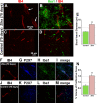Fetal Rhesus Monkey First Trimester Zika Virus Infection Impacts Cortical Development in the Second and Third Trimesters
- PMID: 33341889
- PMCID: PMC8023859
- DOI: 10.1093/cercor/bhaa336
Fetal Rhesus Monkey First Trimester Zika Virus Infection Impacts Cortical Development in the Second and Third Trimesters
Abstract
Zika virus is a teratogen similar to other neurotropic viruses, notably cytomegalovirus and rubella. The goal of these studies was to address the direct impact of Zika virus on fetal development by inoculating early gestation fetal rhesus monkeys using an ultrasound-guided approach (intraperitoneal vs. intraventricular). Growth and development were monitored across gestation, maternal samples collected, and fetal tissues obtained in the second trimester or near term. Although normal growth and anatomical development were observed, significant morphologic changes were noted in the cerebral cortex at 3-weeks post-Zika virus inoculation including massive alterations in the distribution, density, number, and morphology of microglial cells in proliferative regions of the fetal cerebral cortex; an altered distribution of Tbr2+ neural precursor cells; increased diameter and volume of blood vessels in the cortical proliferative zones; and a thinner cortical plate. At 3-months postinoculation, alterations in morphology, distribution, and density of microglial cells were also observed with an increase in blood vessel volume; and a thinner cortical plate. Only transient maternal viremia was observed but sustained maternal immune activation was detected. Overall, these studies suggest persistent changes in cortical structure result from early gestation Zika virus exposure with durable effects on microglial cells.
Keywords: Zika virus; fetus; microglia; monkey; vasculature.
© The Author(s) 2020. Published by Oxford University Press. All rights reserved. For permissions, please e-mail: journals.permission@oup.com.
Figures






Similar articles
-
Zika virus infection at mid-gestation results in fetal cerebral cortical injury and fetal death in the olive baboon.PLoS Pathog. 2019 Jan 18;15(1):e1007507. doi: 10.1371/journal.ppat.1007507. eCollection 2019 Jan. PLoS Pathog. 2019. PMID: 30657788 Free PMC article.
-
The Brazilian Zika virus strain causes birth defects in experimental models.Nature. 2016 Jun 9;534(7606):267-71. doi: 10.1038/nature18296. Epub 2016 May 11. Nature. 2016. PMID: 27279226 Free PMC article.
-
Progressive lesions of central nervous system in microcephalic fetuses with suspected congenital Zika virus syndrome.Ultrasound Obstet Gynecol. 2017 Dec;50(6):717-722. doi: 10.1002/uog.17303. Epub 2017 Nov 8. Ultrasound Obstet Gynecol. 2017. PMID: 27644020
-
Zika Virus-Induced Microcephaly and Its Possible Molecular Mechanism.Intervirology. 2016;59(3):152-158. doi: 10.1159/000452950. Epub 2017 Jan 13. Intervirology. 2016. PMID: 28081529 Review.
-
Zika Fetal Neuropathogenesis: Etiology of a Viral Syndrome.PLoS Negl Trop Dis. 2016 Aug 25;10(8):e0004877. doi: 10.1371/journal.pntd.0004877. eCollection 2016 Aug. PLoS Negl Trop Dis. 2016. PMID: 27560129 Free PMC article. Review.
Cited by
-
Nonhuman Primates in Translational Research.Annu Rev Anim Biosci. 2022 Feb 15;10:441-468. doi: 10.1146/annurev-animal-021419-083813. Annu Rev Anim Biosci. 2022. PMID: 35167321 Free PMC article. Review.
-
Imaging the fetal nonhuman primate brain with SV2A positron emission tomography (PET).Eur J Nucl Med Mol Imaging. 2022 Sep;49(11):3679-3691. doi: 10.1007/s00259-022-05825-6. Epub 2022 May 28. Eur J Nucl Med Mol Imaging. 2022. PMID: 35633376 Free PMC article.
-
Zika Virus: A New Therapeutic Candidate for Glioblastoma Treatment.Int J Mol Sci. 2021 Oct 12;22(20):10996. doi: 10.3390/ijms222010996. Int J Mol Sci. 2021. PMID: 34681654 Free PMC article. Review.
-
Development of the Neuro-Immune-Vascular Plexus in the Ventricular Zone of the Prenatal Rat Neocortex.Cereb Cortex. 2021 Mar 5;31(4):2139-2155. doi: 10.1093/cercor/bhaa351. Cereb Cortex. 2021. PMID: 33279961 Free PMC article.
-
Greater Number of Microglia in Telencephalic Proliferative Zones of Human and Nonhuman Primate Compared with Other Vertebrate Species.Cereb Cortex Commun. 2021 Sep 6;2(4):tgab053. doi: 10.1093/texcom/tgab053. eCollection 2021. Cereb Cortex Commun. 2021. PMID: 34647030 Free PMC article.
References
-
- Andjelkovic AV, Nikolic B, Pachter JS, Zecevic N. 1998. Macrophages/microglial cells in human central nervous system during development: an immunohistochemical study. Brain Res. 814:13–25. - PubMed
-
- Arnò B, Galli F, Roostalu U, Aldeiri BM, Miyake T, Albertini A, Bragg L, Prehar S, McDermott JC, Cartwright EJ et al. 2014. Neural progenitor cells orchestrate microglia migration and positioning into the developing cortex. Nat Commun. 5:5611. - PubMed

